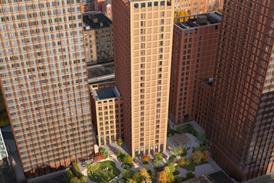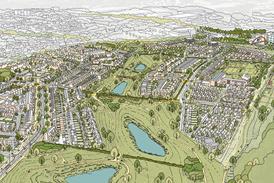More than 50 architecture schools fail to reply to request for details of hidden costs

More than 84% of architecture schools have ignored a demand from RIBA’s student councillors to publish details of the hidden costs of studying at their institutions.
Only eight out of 51 publicly funded colleges responded to the open letter sent by the three student reps in June. Their responses are attached as a pdf below.
The results from those that did respond showed undergraduates can find themselves having to find an extra £1,500 up-front for study trips, printing and model-making.
While some schools cover the cost of compulsory field trips and sell materials at cost price, others don’t – and many have optional trips that students have to stump up for themselves.
This is exactly the point the trio, Simeon Shtebunaev, Selasi Setufe and Abigail Patel, were making – that students with the deepest pockets are most likely to earn the highest marks because they can impress their tutors by going beyond the basic standard.
They want to pressure schools into capping extra costs – and to be clear about them before students enrol. This would help level a playing field that disadvantages poorer students and contributes to a lack of diversity in the profession, they say.
The three, all on RIBA Council, were moved to action after being distressed by the stories of suffering they encountered when they assessed applications to the RIBA student hardship fund.
Patel said: “These additional costs are unexpected cumulative costs which over the course of the year add up considerably.
“While tuition fees are racked up as a separate debt (although very much present in the minds of students) these added course costs mean that many people will find themselves having to sacrifice budgeted living costs in order to survive through their architectural courses.
“Students should not in any circumstances feel they cannot afford basic living costs some weeks simply because they have had to do excessive printing or model making.”

Patel, Shtebunaev and Setufe praised the seven schools that replied for leading by example and for demonstrating an “encouraging” commitment to reducing costs.
They warned the 44 that didn’t reply that they are required by the Competition and Markets Authority (CMA) to be clear about costs, including those not covered by tuition fees.
“We strongly believe that costing degrees in an honest and transparent manner should be a prerequisite for any architectural course and would encourage any student to report misleading information to the CMA,” they said.
They intend to push for the true costs of architectural education to be taken into account by accreditation panels and in university rankings and are planning a guide for students on university best practice.
“The voice of future architects needs to be strengthened, so their opinions and needs can be heard by accreditation bodies, universities and government alike,” they said.
They are also planning to establish an international network of students, kicking off with a conference in November.
Response by the RIBA student representatives
Seven universities, out of the 51 publically funded institutions on the RIBA accreditation list, led by example and replied to our open letter regarding the cost of architectural education. Those were: The University of Cambridge, The University of Sheffield, The University of Westminster, The University of Cardiff, Queen’s University Belfast, Coventry University and Plymouth University.
We welcome their responses and we welcome the initiatives that they have exemplified in their letters to us. The replies demonstrate that this issue is not only pertinent to students but to educators as well, both sides having a desire to alleviate the financial costs of courses.
We regret that 44 other universities did not reply to our letter and would like to stress that the Competition and Markets Authority already requires Higher Education providers to be clear about the costs to students including those that are not covered by tuition fees. We strongly believe that costing degrees in an honest and transparent manner should be a prerequisite for any architectural course and would encourage any student to report misleading information to the CMA.
On field trips: We are encouraged by the fact that the majority of respondents fund any field trips compulsory to the degrees or provide local alternatives for optional trips abroad. We encourage others to work to achieve courses that provide fully funded field trips, in consideration of sustainability impact and learning outcomes. We are opposed to compulsory field trips that are not fully funded as part of any module, studio or programme.
On large scale models: We are encouraged by the different alternatives developed by universities to provide facilities for model making and reduce costs and acknowledge that model making is often hard to quantify. We believe that compulsory model making should be subsidised.
On printing: We are encouraged by the trend of respondents to incorporate digital submissions, digital screens, provide printing credits and encourage smaller format portfolio submissions, where these are not essential. We believe that essential printing should be subsidised.
On overall costs: We do not agree that university hardship funds should be quoted as provisions to students as hardship funds are intended to be an absolute last resort. We encourage proactive approaches towards design and costing of modules and will continue to promote such approaches.
Our immediate next step will be to bring this issue to the RIBA Education Committee and work on developing a publication to advise students about our view on best practice. We will encourage further research to be undertaken into the cost of architectural education and for these costs to be taken into account by accreditation panels, criteria and university rankings. We will continue our engagement with the RIBA and Arb. The voice of future architects needs to be strengthened, so their opinions and needs can be heard by accreditation bodies, universities and government alike.
In our capacity as RIBA representatives, we are working to establish an international network of our students, associates and graduates to link all Future Architects together, consolidate the offer of the institute and provide a platform for collective action. We invite all interested parties – students, educators and graduates to Birmingham on the 3rd of November 2018 to discuss our next steps. We will be reviewing all responses and compiling strategic action plans at the conference. We will welcome all 44 universities that have not replied to our initial call to do so in the months to November.
We acknowledge that the issue of costs runs deeper than architectural departments and touches on central university funding, course sizes and government policy. We welcome further collaboration with Schosa to promote the importance of those issues.
Abigail Patel, Student Representative on RIBA Council, North West Regional Council; Selasi Setufe, Associate Representative on RIBA Council, co-VP Students and Associates; Simeon Shtebunaev, Student Representative on RIBA Council, co-VP Students and Associates
Downloads
Schools' responses to open letter
PDF, Size 0.18 mb













10 Readers' comments